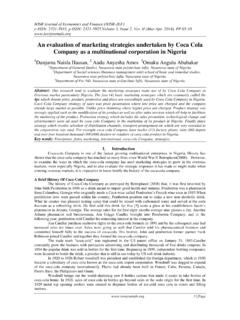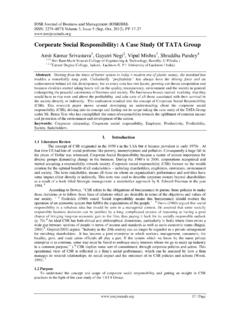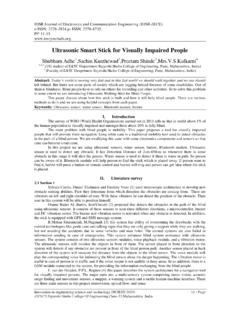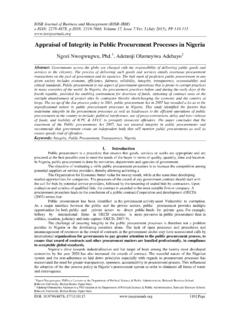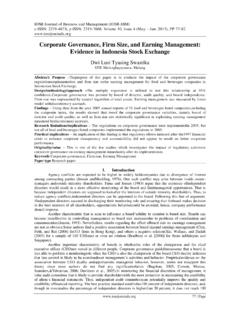Transcription of The Emerging Urban Co-Operative Banks (Ucbs) In …
1 IOSR Journal of Business and Management (IOSRJBM) ISSN: 2278-487X Volume 2, Issue 5 (July-Aug. 2012), PP 01-05 1 | Page The Emerging Urban Co-Operative Banks (Ucbs) In India: Problems and Prospects Jawahar Babu, Selkhar 1 Professor, KMM Institute of Technology& Science, Tirupati. 2 Assistant Professor, KMM Institute of Postgraduate Studies, Tirupati. Abstract: Urban Co-Operative banking Sector is an important constituent of Multi Agency banking system operation in the country. These institutions play an important role in the economic enlistment of lower and middle-income group of persons. The Reserve bank of India in its annual report on trends and progress in banking states that Urban Banks are important purveyors of credit to small borrowers and to weak sections of the society but is not coming out with any supportive policies that will strengthen the role of UCBs.
2 I. Introduction: Urban Co-Operative Banks The term Urban Co-Operative Banks (UCBs), though not formally defined, refers to primary Co-Operative Banks located in Urban and semi- Urban areas. These Banks , till 1996, were allowed to lend money only for non-agricultural purposes. This distinction does not hold today. These Banks were traditionally centered on communities, localities, work place groups. They essentially lend to small borrowers and businesses. Today, their scope of operations has widened considerably. Urban cooperative Banks were set up with the objective of promoting sustainable banking practices amongst a relatively specific target clientele viz., the middle income strata of the Urban population.
3 They were brought under the regulatory ambit of the Reserve bank by extending certain provisions of the banking regulation act, 1949, effective from march 1, 1966. Background of UCBs The origins of the Urban Co-Operative banking movement in India can be traced to the close of nineteenth century. Inspired by the success of the experiments related to the cooperative movement in Britain and the Co-Operative credit movement in Germany, such societies were set up in India. Co-Operative societies are based on the principles of cooperation, mutual help, democratic decision making, and open membership. Cooperatives represented a new and alternative approach to organization as against proprietary firms, partnership firms, and joint stock companies which represent the dominant form of commercial organization.
4 They mainly rely upon deposits from members and non-members and in case of need, they get finance from either the district central Co-Operative bank to which they are affiliated or from the apex Co-Operative bank if they work in big cities where the apex bank has its Head Office. They provide credit to small scale industrialists, salaried employees, and other Urban and semi- Urban residents. Co operative Banks in India are registered under the Co-Operative Societies Act. The cooperative bank is also regulated by the RBI. They are governed by the Banking Regulations Act 1949 and Banking Laws ( Co-Operative Societies) Act, 1965. A Co-Operative bank is defined as "a financial entity which belongs to its members, who are at the same time the owners and the customers of their bank .
5 The term Urban Cooperative Banks (UCBs), although not formally defined, refers to the primary cooperative Banks located in Urban and semi- Urban areas. These Banks , until 1996, were allowed to lend money only to non-agricultural purposes. This distinction remains today. These Banks have traditionally been around communities, localities working out in essence, loans to small borrowers and businesses. Today their scope of operation has expanded considerably. Status of UCBs in India: Indian Banking system is on its sound footing UCBs in India are playing major role in servicing rural economy and there is no need to worry as evident from following data regarding UCBs in India. Total Number of Banks in India 1770 Total Deposits , 12,000 crs Total Advances Rs.
6 78,000 crs. Total No. of scheduled Banks in India 53 Total Mahila Banks 139 Total No. of Mahila Banks in Mah. 27 Total 1 Unit Banks 900 Salary Earner Banks 24 The Emerging Urban Co-Operative Banks (UCBs) in India: Problems and Prospects 2 | Page Total deposits of scheduled Banks Rs. 51,173 crs (42% of total deposits of UCBs) Total advances scheduled Banks Rs. 32, 884 crs. Gradation of Banks all India level Grade-I Banks 690 Grade-II 430 Grade-III 390 Grade-IV 260 With the onset of liberalization, Co-Operative Banks in India are under pressure to change the ways in which they do business. They now face an increasingly competitive environment not only from Banks but also from non- bank financial institutions.
7 Explosive growth in IT has changed the way individuals interact with Banks and the way Banks respond. In the changed scenario, success will depend on the ability of Banks to leverage the human potential and capabilities, Marketing of Banking products, G-sec Market, Customer value added services, competitive pricing of deposits and advances, good corporate governance, information & Technology. Co-Operative banking The challenges ahead In recent years, there has been a considerable widening and deepening of the Indian financial system, of which banking is a significant component. With greater liberalization, the financial system has come to play a much larger role in the allocation of resources than in the past and its role in future can be expected to be much larger than at present.
8 The growing role of the financial sector in the allocation of resources has significant potential advantages for the efficiency with which our economy functions. Net profits of UCBs improved in 2010-11 as compared to the previous year owing to higher growth of their total income. But the gross as well as net NPA ratio of UCB sector declined. The following areas required to take certain measures to be strengthened The pattern of resources of Urban cooperative Banks (owned funds, deposits, and borrowings) The deployment of resources The management and supervision The role of UCBs in the financial system The regulatory framework for cooperatives The following measures Strengthening of regulatory and supervisory framework Enhancing capital adequacy standards Introducing stringent licensing norms for new entrants into the sector Enabling legal amendments and Corporate governance measures need to be given very close attending II.
9 Review of Growth of Urban Co-Operative Banking Sector While reviewing the progress made by the Urban Co-Operative Banks during the last 10 years, it was observed that the performance has by and large been satisfactory (Table- ). Though there has been reduction in the number of UCBs from 2004 onwards, the total banking business (deposits plus advances) of UCBs has shown steady increase signifying that the Banks have been able to garner more business. Table- : Performance of UCBs Deposits and Advances As on March 31 No. of UCBs Deposits (` Crore) Advances (` Crore) 2001 1618 80840 54389 2002 1854 93069 62060 2003 1941 101546 64880 2004 1926 110256 67930 2005 1872 105021 66874 2006 1853 114060 71641 2007 1813 121391 79733 2008 1770 138496 88981 2009 1721 158733 97918 2010 1674 182862 110303 2011 1645 209949 135104 Note: Provisional data as on March 31,2011 is based on OSS statements.
10 The Emerging Urban Co-Operative Banks (UCBs) in India: Problems and Prospects 3 | Page Profitability Indicators Table- : Return on Assets and Net Interest Margin Scheduled Commercial Banks (SCBs) vis- -vis Urban Co-Operative Banks (UCBs) (In Percentage) Year ended 31st March All SCBs(Excluding Regional Rural Banks ) All Scheduled UCBs All UCBs Return on Assets Net Interest Margin Return on Assets Net Interest Margin Return on Assets Net Interest Margin 2005 NA NA 2006 NA NA 2007 2008 2009 2010 NA Data Not Available Source: Report on Trend and Progress of Banking in India Return on Assets = Net Profits/ Average Assets Net Interest Margin = Net Interest Income ( Interest Income - Interest Expenses) / Average Assets The performance of the UCB sector other than in the area of market share is comparable with the performance of the Scheduled Commercial Banks (Table- ).
